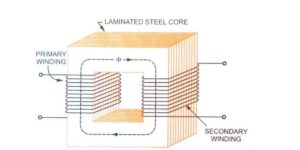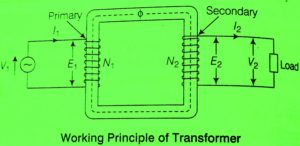What is a Transformer?
Let’s start our new article on what is a transformer? In this article, we will discuss the transformer principle, construction, and working, and also the advantages of a transformer.
A transformer is a static device (has no rotating parts) that consists of two or more stationary electrical circuits interlinked by a common magnetic circuit for the purpose of transferring electrical energy between them. The transfer of energy from one circuit to another circuit takes place without a change in frequency.
It can increase or decrease the voltage with a corresponding decrease and increase in current. It can change low alternating voltage to high alternating voltage to low alternating voltage and in both cases, the frequency remains unchanged.
Since it has no rotating parts so the efficiency of the transformer is very high (in the range of 96-99% )
It is an ac machine so it is never operated on dc as if the transform’s primary winding is connected to the dc supply, then the winding catches fire. This is due to the fact that in the absence of inductance and inductive reactance its resistance value is low. Hence, the value of the current will be high, and the winding catches fire.
When a transformer changes a lower input voltage to a higher input voltage then, in this case, it is called a step-up transformer whereas when it changes a higher output voltage into a lower output voltage then it is called a step-down transformer.
Construction of the transformer
It consists of primary and secondary winding which is put on a magnetic core. Both the windings are not electrically but connected magnetically.
- Primary winding– primary winding in the winding is connected to the electric supply and produces the magnetic flux as shown in the diagram.
- Secondary winding– This winding is connected to the load, the flux produced by the primary winding passes through the magnetic core will link with the secondary winding.
- Magnetic core-The primary winding produces the magnetic flux which will pass through the low reluctance path linked with the secondary winding and creates a closed magnetic circuit the core is made up of laminations. Generally, high-grade silicon steel laminations are used. some of the laminations are heat-treated to produce a high permeability and a low hysteresis loss. The eddy current loss is minimized by laminating the core. Each lamination is insulated from the other by a light coat of varnish(enamel).

fig: transformer
Principle and working of a transformer
Principle
The function of a transformer, as the name implies is to transform alternating current energy from one voltage into another voltage. The transformer follows Faraday’s law of electromagnetic induction which states that the rate of change of flux linkage with respect to time is directly proportional to the induced emf in a conductor or a coil.
Hence, mutual induction between two or more winding is responsible for the transformer action in an electrical transformer.
Working of transformer
When the primary winding of a transformer is connected with an ac supply then due to the flow of alternating current a magnetic flux or field of alternating nature is developed which completes its path through the common magnetic core.

The conductors of the secondary winding cross the magnetic flux lines which were developed by the magnetic field of the primary winding and this flux induces an electromotive force, according to Faraday’s law of electromagnetic induction. Since the magnetic flux developed by the primary is of alternating nature, therefore conductors of secondary winding cross the magnetic flux lines.
In this way without any direct connection or touch between both the windings, the transfer of energy takes place between primary and secondary windings, this action of the transformer of energy is called the transformer action. If now the load is connected to the secondary winding, the induced emf drives a current through it.
Advantages of a transformer
- It is a static device and there is no movable present in it and hence, no tear and wear on it.
- It requires very little care and maintenance.
- Voltage can be stepped up and stepped down easily as per need.
- Its efficiency is very high.
- Its maintenance cost is low.
- Transmission and distribution become cheaper as a result aluminum or copper is saved.
I hope you like this post on ‘what is a transformer’. For more related topics comment below.
